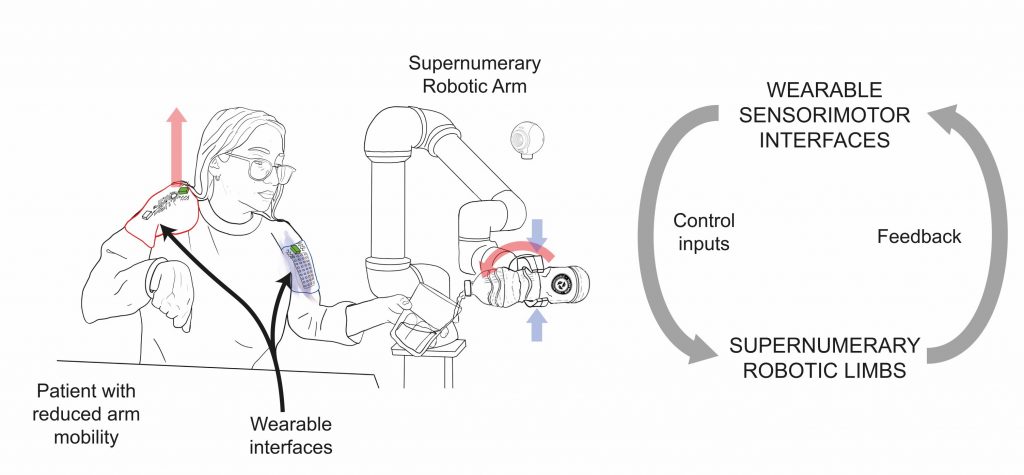OBJECTIVES
HARIA re-defines the nature of physical human-robot interaction, laying the foundations of a new research field, i.e., human sensorimotor augmentation. The idea is to study how to integrate humans and AI-powered supernumerary robotic limbs to perform complex manipulation tasks with both biological and artificial limbs under the direct control of the human.
A fundamental challenge in HARIA will be to find the right trade-off between motion task parameters that are controlled by the user, and the level of robot autonomy. The enabling core technology of this interplay is the wearable sensorimotor interface that establishes a connection between the human sensorimotor system and the system of actuators and sensors of the robot, allowing for reciprocal awareness, trustworthiness, and mutual understanding. The sensorimotor interface captures signals from human body motion, or muscle activation, that are mapped onto commands for the robot limbs using a novel approach that exploits the redundancy of the human sensorimotor system. This will lead to the simultaneous control of natural and artificial limbs. Interfaces will also exploit combinations of somatosensory stimuli to convey haptic sensations related to the task at hand, further improving users’ control accuracy and level of engagement in the collaboration. HARIA sensorimotor augmentation will be applied to assist people with upper-limb disabilities, focusing on two target populations: chronic stroke and spinal cord injured patients.

EXPECTED IMPACT
AI-powered enabling technologies for human sensorimotor augmentation. HARIA will develop robotic systems with improved manipulation capabilities and dexterity, together with novel sensorimotor human-robot interfaces combining input and feedback devices to establish a connection between the human user and the robotic limb.
Advanced controllers for human sensorimotor augmentation. HARIA will devise novel methodologies to combine bio-signals and human body motions captured by the wearable interfaces together with scene understanding and intelligent role assignment to generate the control of the robotic supernumerary limbs. Information on task execution captured by the robot sensors will be fed back to the human through haptic signals for enhancing the human perception of supernumerary limbs, their agency, and task execution awareness.
Supernumerary limbs for people with disabilities. So far, wearable extra limbs have been mainly used to augment healthy humans’ capabilities, while collaborative arms and grippers have been mainly applied to industrial assembly tasks. HARIA focuses on applying these technologies as assistive devices and targets a large set of end-users with upper-limb disabilities. HARIA systems will be integrated in three different scenarios involving activities of daily living to be performed by selected stroke survivors and spinal cord injured individuals. Thanks to the sensorimotor interfaces, users will be actively in charge of controlling the robot. This will represent a strong motivation for using HARIA devices, ensuring their long-term adoption.
Long term impact on the healthcare domain and beyond. The societal mid-term impact on life after stroke and spinal cord injury will be evident in the recovered autonomy in the execution of daily activities, leading also to a positive consequence for caregivers and rehab facilities. A societal long-term impact is expected in domestic rehabilitation and homecare thanks to the possibility of exploiting remotely, at home, the HARIA technologies. In addition, the outcomes of the project will impact other domains of the service robotics field, defining novel paradigms for human-robot communication.